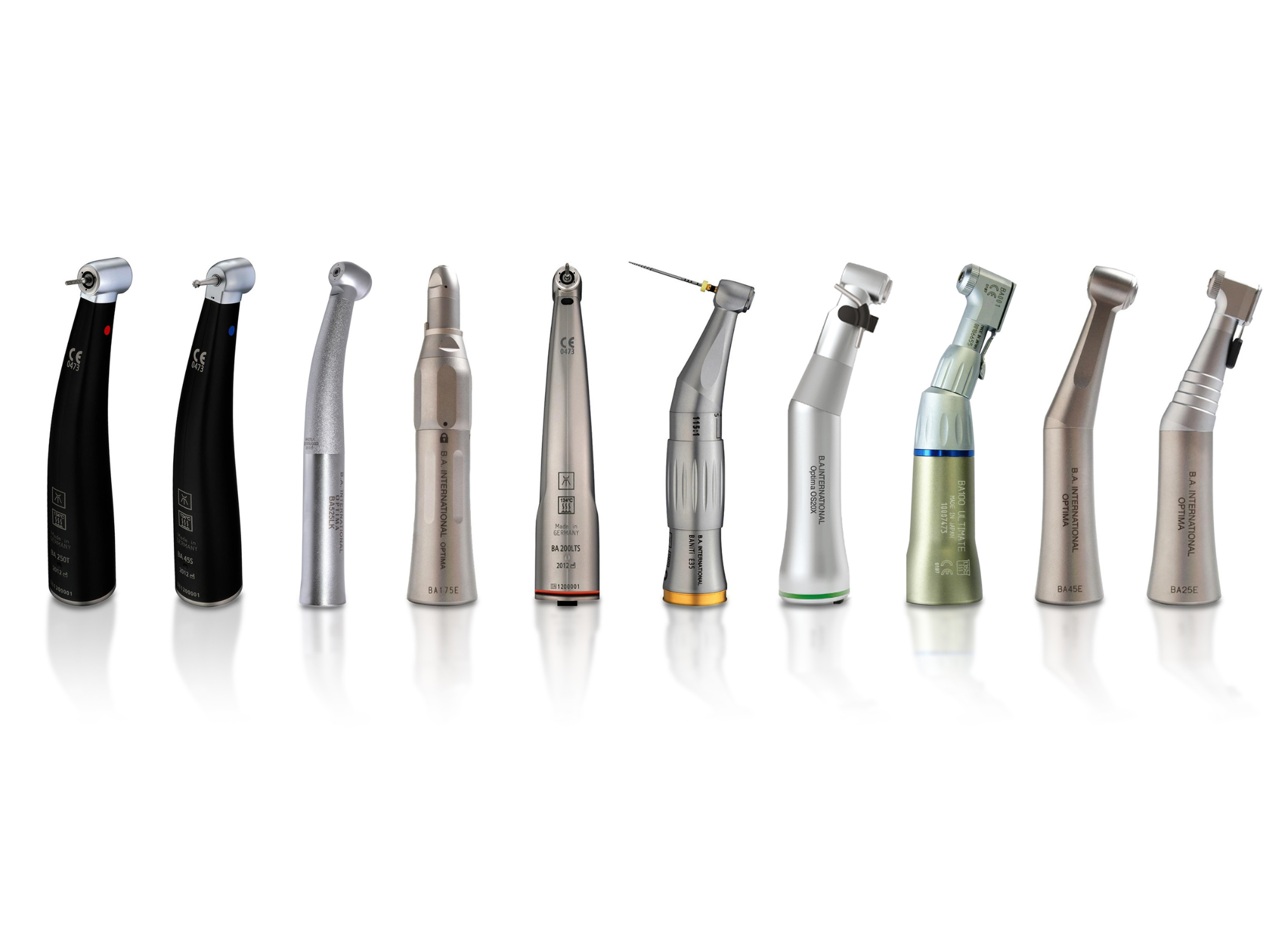Mastering dental handpieces: demystifying the choices

Navigating the world of dental handpieces can be a real challenge. With so many options available, telling one from another can seem impossible. That's where our guide comes in. We've taken all the complicated stuff and made it easy to understand. You can see what makes each handpiece different easily, it will even introduce you to solutions from BA International, so you can be sure you’re getting the handpiece you want.
Get ready to demystify dental handpieces and make smart choices with confidence.
Understanding dental handpieces
Dental handpieces are indispensable tools in a dentist's toolkit, utilised daily for a variety of procedures. Our guide is here to illuminate the landscape of dental handpieces, explaining the distinct types, their primary functions, and key attributes, all aimed at facilitating your informed decision-making process.
Types of dental handpieces
High-speed turbines
High-speed turbines are self-contained air driven units. These handpieces can be seamlessly attached to compatible dental unit hoses for immediate use or via a coupling that sits between the hose of the unit and the base of the high speed turbine. With a subtly curved design, they feature versatile heads accommodating various dental burs (FG). The handpiece's rotational motion, essential for cutting and polishing, is powered by the internal air turbine. A simple step on the dental foot pedal activates this mechanism.
Lubricated ball bearings within the handpiece head ensure smooth and low-friction rotation of the bur. High-speed handpieces can achieve impressive speeds of up to 450,000 rotation per minute (rpm). The air and water spray, emitted from two small holes on top of the head, serve to prevent overheating during procedures, the number of spray holes in the head can vary depending on the model.
High speed turbines are versatile tools used for a range of dental procedures, including:
- Removing decay from teeth.
- Taking out old fillings.
- Preparing the outline and retention grooves for new restorations.
- Finishing or polishing newly placed restorations.
- Preparing crowns or bridges.
Our recommendation: If a high-speed turbine sounds like what you need, check out the BA525 range from BA International. The BA525 range is a powerful 20W quadruple spray handpiece, with fibre optics, easy grip coating, and ceramic bearings. The different models in the range come with different fittings, including Bien Air, NSK, W&H, and KaVo.
If you want to browse more options, click the link below to find a curated list of trusted BA International high-speed turbines to suit your needs!
Low-speed handpieces
Contrasting their high-speed counterparts, low-speed handpieces consist of multiple components. They require attachment to a motor, which can be either air or electric driven, for operation.
These handpieces excel in precision tasks, operating at speeds ranging from 10,000 to 40,000 rpm. Contra-angle and straight handpieces cater to intraoral and extraoral applications, respectively. Some models even feature water spray for enhanced versatility.
Contra-angle and straight handpieces cater to intraoral and extraoral applications, respectively. Some models even feature water spray for enhanced versatility.
Low speed handpieces are valuable for more intricate and controlled procedures, such as:
- Precise removal of decay.
- Refining and smoothing cavity preparations.
- Polishing and perfecting restorations.
- Adjusting crowns, bridges, and dentures.
- Trimming and contouring temporary crowns.
- Reline adjustments for removable dentures.
- Shaping and adjusting orthodontic appliances.
Our recommendation: If a low-speed dental handpiece is what you need in your surgery, our recommendation is the OPTIMA BA25E from BA International. A 1:1 direct ratio contra-angle model, the BA25E offers no spray, an easy-to-clean surface, and latch type chuck. It is also thermo-disinfectable and autoclavable, for added convenience.
If you want to browse more options, click the link below to find a curated list of trusted BA International low-speed turbines to suit your needs!
Electric handpieces
 Electric handpieces, despite their slightly higher cost and slightly heavier build, bring forth a host of advantages rooted in their superior power, control, and torque. Unlike their air-driven counterparts, electric handpieces exhibit an unwavering speed throughout operation, ensuring steady and reliable performance across various dental tasks. This unique attribute makes them particularly well-suited for intricate procedures, such as endodontic treatments, where precision and consistency are paramount.
Electric handpieces, despite their slightly higher cost and slightly heavier build, bring forth a host of advantages rooted in their superior power, control, and torque. Unlike their air-driven counterparts, electric handpieces exhibit an unwavering speed throughout operation, ensuring steady and reliable performance across various dental tasks. This unique attribute makes them particularly well-suited for intricate procedures, such as endodontic treatments, where precision and consistency are paramount.
Another advantage of electric handpieces lies in their ability to minimise aerosol generation. Unlike air-driven handpieces that can contribute to airborne particles, electric handpieces generate fewer aerosols during use. This helps with infection control, fostering a cleaner and safer environment for both dental professionals and patients alike.
Electric handpieces offer enhanced control and power for various dental tasks, including:
- Efficient removal of decay and tooth structure.

- Precision cavity preparation and shaping.
- Accurate finishing and polishing of restorations.
- Adjusting and fitting crowns, bridges, and dentures.
- Procedures requiring consistent torque and power.
- Versatile for a wide range of dental applications.
- Reduced aerosol production for better infection control.
- Adjustable torque settings for different procedures.
Our recommendation: The ULTIMATE BA250T is a fantastic electric handpiece. A 1:5 speed-increasing contra-angle model, the BA250T has a PVD ‘smart coat’ for better grip, ceramic bearings, an anti-retraction valve, and quadruple spray.
If you want to browse more options, click the link below to find a curated list of trusted BA International electric handpieces to suit your needs!
Contra-angle handpieces
Contra-angle handpieces, easily recognisable by their distinctive curved design, are expertly crafted for optimal performance within the oral cavity. Their unique configuration allows for seamless manoeuvrability and precise control, making them an indispensable tool for a multitude of intraoral applications.
Here's a closer look at their versatile capabilities:
 Decay removal: Contra-angle handpieces excel in the precise removal of decayed tooth material. Their ergonomic design facilitates easy access to challenging areas, ensuring thorough removal while preserving healthy tooth structure.
Decay removal: Contra-angle handpieces excel in the precise removal of decayed tooth material. Their ergonomic design facilitates easy access to challenging areas, ensuring thorough removal while preserving healthy tooth structure.
Cavity preparation: When it comes to cavity shaping and refinement, contra-angle handpieces offer unparalleled precision. Dentists can confidently create accurate cavity outlines, ensuring optimal conditions for successful restorations.
Restoration finishing: The refined rotational motion of contra-angle handpieces lends itself perfectly to the delicate task of polishing and refining restorations. This ensures a smooth and natural finish, enhancing both aesthetics and patient comfort.
Adjusting crowns and bridges: Fine-tuning crowns, bridges, and dentures demands a tool that combines finesse with control. Contra-angle handpieces provide just that, enabling dentists to make precise adjustments that ensure proper fit and function.
With their curved design and exceptional manoeuvrability, contra-angle handpieces stand as versatile companions for dentists, offering a reliable means to execute these intricate procedures with confidence and proficiency.
Our recommendations: If a contra-angle handpiece is what you need then BA International can offer a wide range of solutions. View the full range here or browse the best-sellers below!
| Model | Features |
| BA101 |
|
| BA45E |
|
| BA45S |
|
| BA200LTS |
|
If you want to browse more options, click the link below to find a curated list of trusted BA International contra-angle handpieces to suit your needs!
Straight handpieces
 Straight handpieces are purposefully crafted for a range of tasks outside the oral cavity, offering remarkable control and robust power. Their straightforward design conceals their exceptional versatility, and they particularly excelling in the following applications:
Straight handpieces are purposefully crafted for a range of tasks outside the oral cavity, offering remarkable control and robust power. Their straightforward design conceals their exceptional versatility, and they particularly excelling in the following applications:
Temporary crown trimming and contouring: Straight handpieces come into their own when it comes to the precise shaping of temporary crowns. The controlled rotational motion facilitates accurate contouring, ensuring optimal fit and patient comfort.
Removable denture trimming and relining: Adjusting and relining removable dentures demand a tool that combines precision with efficacy. Straight handpieces provide the necessary finesse, allowing dentists to make adjustments that guarantee a snug and comfortable fit for the patient.
Orthodontic appliance work: Contouring and adjusting orthodontic appliances require a tool that can navigate intricate details with ease. Straight handpieces rise to the occasion, enabling dentists to finesse these appliances for optimal patient comfort and treatment effectiveness.
In the realm of extraoral procedures, straight handpieces will prove to be indispensable allies, offering dental professionals the means to accomplish these tasks with finesse and confidence. Their reliable performance and versatility make them an invaluable addition to any dentist's toolkit.
Our recommendation: If it’s a straight handpiece you need, we recommend the BA175E from BA International. The BA175E is a 1:1 ratio straight dental handpiece that you can rely on. It has an easy-to-clean surface and is thermo-disinfectable and autoclavable for maximum convenience. It is also non-fibre optic and has no spray.
If you want to browse more options, click the link below to find a curated list of trusted BA International straight handpieces to suit your needs!
Specialist handpieces
When faced with unique and intricate dental procedures that demand an elevated level of precision and performance, turning to specialised handpieces can significantly enhance the quality of your work and patient outcomes.
 Endodontic and surgical handpieces are purpose-built to cater to the intricacies of specific treatments, offering features and functionalities that are finely tuned to address the challenges inherent to these specialised fields.
Endodontic and surgical handpieces are purpose-built to cater to the intricacies of specific treatments, offering features and functionalities that are finely tuned to address the challenges inherent to these specialised fields.
Endodontic handpieces: For intricate root canal procedures, endodontic handpieces are engineered with precision and control in mind. Their specialised design facilitates optimal access, ensuring that you can navigate the complexities of root canals with the utmost accuracy. These handpieces are equipped to handle the unique demands of shaping, cleaning, and filling root canals, contributing to successful treatment outcomes and patient comfort.
Our recommendation: Try the BA BAE45 endodontic contra-angle handpiece, compatible with most endodontic NiTi files. It is a 66:1 ratio speed reducer for air motors that requires no tabletop unit. The model has easy torque settings and a retro-rotation system to prevent excessive torque.
Surgical handpieces: Oral and maxillofacial surgery and implantology demand a level of durability and robustness that standard handpieces may not provide. Surgical handpieces are meticulously crafted to withstand the demands of these high-impact procedures. Their sturdy construction, often featuring high-quality stainless steel, ensures reliable performance during surgical interventions. Additionally, the availability of both contra-angle and straight configurations allows for versatility in different surgical scenarios.
Incorporating specialised handpieces into your practice showcases a commitment to delivering superior patient care in specific treatment areas. By leveraging these tools, you can navigate complex procedures with enhanced precision and efficiency, ultimately contributing to the success of your specialised treatments.
Choosing the right handpiece
You now understand the difference between the core types of dental handpieces, but there is still more to consider if you want to ensure you select the perfect option for your dental practice.
When selecting a handpiece, several more factors come into play.
Gear ratios: precision in performance
Within the realm of dental handpieces, gear ratios play a crucial role in determining the speed and versatility of each tool.
- Higher gear ratios: Think of higher gear ratios as the turbochargers of the dental world. These handpieces are your go-to for heavy-duty tasks that demand high speeds and efficient material removal. A gear ratio of 1:5 or similar accelerates the bur’s rotation, making it the ideal choice for procedures like cavity preparations and crown cutting. When precision meets power, these handpieces shine.
- Lower gear ratios: On the other end of the spectrum, lower gear ratios are like the gentle maestros, conducting delicate and intricate procedures with finesse. A handpiece with a 1:1 ratio maintains a steady rotation, making it perfect for tasks that require meticulous attention to detail. Refining a preparation, removing caries, or adjusting ceramics find their ideal match in these lower gear ratios, where control and precision are paramount.
Recognising gear ratios is made simpler through a universal colour coding system. This coding, represented by coloured rings on the handpiece, offers a quick visual guide to gear ratios. A red ring signifies a speed-increasing ratio, a green ring denotes a speed-reducing ratio, and a blue ring indicates no change in speed.
Couplings: ensure compatibility
It is vital that you ensure your handpiece is compatible with your dental chair hose as well as the base of your existing handpiece if it’s a replacement, so you need to be aware of what coupler you are purchasing.
- Borden coupler: The Borden style coupling is a widely used connection mechanism, distinguished by its two or three distinctive holes. These openings serve specific functions: a larger hole channels air for turbine rotation, while a smaller hole manages water flow.
%20(1).png?width=424&height=463&name=Untitled%20(500%20%C3%97%20600px)%20(1).png) This design ensures efficient cooling and smooth operation. Borden couplers lack an air exhaust, directing air directly out of the handpiece.
This design ensures efficient cooling and smooth operation. Borden couplers lack an air exhaust, directing air directly out of the handpiece. - Midwest coupler: The Midwest style coupling has versatility with two or more larger holes. One hole is dedicated to air intake, while another serves as the air exhaust. Additional holes often accommodate water spray and fibre optics for enhanced illumination during procedures.
- Six pin couplers: Emerging on the scene, new style couplers equipped with six pins provide a contemporary connection solution. These advanced couplers ensure compatibility with handpieces featuring a six-pin connection design.
Further factors to consider:
- Head Size: The head size impacts visibility and torque, opt for smaller heads for precision in posterior procedures and larger heads for enhanced cutting power.
- Ergonomics: Lighter and well-balanced handpieces enhance comfort during extended use. Some models, like the BA250LT and BA200LTS, even feature an enhanced grip coating.
-1.png?width=406&height=406&name=Untitled%20design%20(21)-1.png)
- Bearings: Choose between ceramic and stainless-steel bearings, with ceramics being more durable. Regular cleaning and lubrication are essential for optimal performance.
- Maintenance and Repairs: Follow manufacturer maintenance guidelines to extend the lifespan of your handpiece. Prioritise repair over replacement when encountering issues like excessive vibrations or reduced rotation speed.
Now that you know the difference between handpieces and where each kind excels, you're better equipped to make informed decisions tailored to your specific dental procedures. As you explore the diverse landscape of dental handpieces, keep in mind the unique advantages each type offers and how they align with your practice's needs. Whether you're seeking precision for intricate tasks or power for heavy-duty procedures, understanding these distinctions will guide you toward selecting the perfect handpiece to elevate your dental practice.

